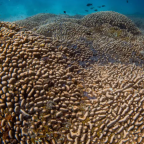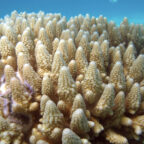
A chemical found in many soaps, laundry detergents and cosmetics is killing young coral reefs at concentrations commonly found in the environment, according to a new study. Corals, which provide habitat for a rich array of fish and other marine life, are threatened worldwide. The new study is the first to find that benzophenone-2 (BP-2) is toxic to coral reefs, although it builds upon previous studies that reported that corals are harmed by other chemicals in wastewater and runoff.
Researchers exposed baby corals in a laboratory to different concentrations of BP-2, which is found in hundreds of personal care products. Increased BP-2 exposure caused increased rates of coral death, DNA damage and bleaching, which is when corals turn white, are stressed and more likely to die.
The levels of BP-2 used in the study — ranging from 24 parts per billion to 246 parts per million — are within what has been found in US wastewater effluent.
Once in the environment, BP-2 can quickly “kill juvenile corals at very low concentrations — parts per billion,” the authors wrote.
“What’s worrying is that if this chemical harms young coral, we won’t get coral recruitment around the world,” said Craig Downs, a researcher at Haereticus Environmental Laboratory in Virginia who led the study. “This will create coral zombies — where’s there’s adults but not recruited young, so the reef will eventually go away.”
The Great Barrier Reef alone has had roughly 50 per cent of its corals disappear over the past 50 years from cyclones, crown-of-thorns starfish and climate change. Run-off from land laced with pesticides, petroleum compounds and agricultural nutrients such as phosphorous and nitrogen also threaten coral reef health.
“This is more bad news for coral reefs, more evidence of the pervasive and pressing impacts of land-based sources of pollution,” said Michael Risk, a professor at Canada’s McMaster University in a prepared statement. Risk was not involved in the study.
“The results show that something humans use to protect their skin or toiletries can reach the sea from wastewater discharges, and shut down coral reproduction,” he said.
Downs warned of the economic impact. He said the roughly 3,000 square kilometres of coral reefs in the United States generate more than a billion US dollars per year due to coastal protection, fisheries, tourism, recreation and biodiversity promotion, according to a 2003 study. The Great Barrier Reef contributes approximately $7 billion to the Australian economy (pdf).
BP-2 also has been linked to cancer and thyroid disruption in people.
The chemical is used to protect bath salts, body fragrances, lotions, shampoos, soaps and laundry detergents from ultraviolet light, which make products lose their colour.
Often found in wastewater, it is considered an emerging contaminant of concern by the US Environmental Protection Agency.















Social Profiles